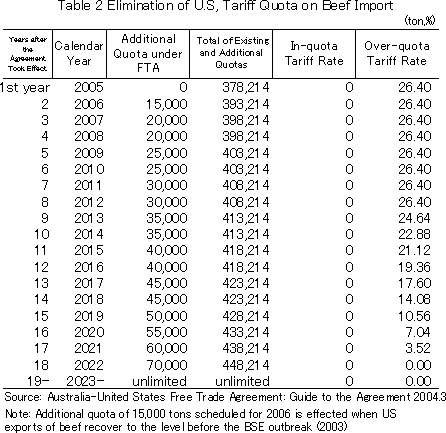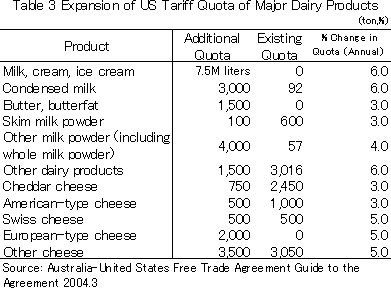|
Analysis of the Economic Impact of the US-Australia Free Trade Agreement ―Focusing on Agricultural Issues― |
|
2. Analysis of Trade Liberalization Negotiations, Based on Bargaining Theory 3. US-Australia Free Trade Agreement |
|||
|
3.US-Australia Free Trade Agreement With respect to agriculture, the US-Australia FTA stipulates as follows; (1) Beef The United States' tariff quota system on beef imports will lower the barrier gradually, as detailed below, until it is finally eliminated (Table 2). In the second year after the FTA took effect (i.e. 2006) a 15,000 ton quota is permitted in addition to the current quota, provided, however, that the 15,000 ton quota becomes effective only if beef exports by the US recover to the level of 2003 before the outbreak of BSE. In the 3rd year (2007) the quota will be increased by 5,000 tons to total 20,000 tons per year. Then the quota will be increased by 5,000 tons every two years, and then increased by 5,000 tons a year from the 15th year (2019). Finally in the 18th year (2022) the quota will reach 70,000 tons and the tariff quota will be abolished and inapplicable from the 19th year (2023). Currently the in-quota tariff rate is zero. The tariff rate applicable to over-quota exports begins at 26.4% and will be gradually lowered over the period from the 9th to the 18th year (2013-2022) and from the 18th year onward, the over-quota tariff rate will be reduced to zero.
The US was allowed to set a safeguard system to prevent an abrupt increase in beef imports. The safeguard is triggered in two ways. The first is quantity-based. During the 18-year transitional period after the effective date of the Agreement, the safeguard is triggered when beef exports from Australia to the US exceed 110% of the quota allowed for the year under the FTA. In the 15th year (2019), for example, the authorized quota is 50,000 tons. Therefore, if over-quota imports exceed 5,000 tons, the quantity safeguard will be triggered. When this happens, any additional over-quota exports would be subject to tariff at the rate of 11.84%, three quarters of the difference (15.84%) between the current 26.4% tariff and the 10.56% tariff in the 15th year. In effect, the over-quota tariff is 10.56% in the 15th year, but is raised to 22.44% after the quantity safeguard is triggered. Nonetheless, the tariff is still lower than the current over-quota tax rate. Secondly a price-based safeguard applies. For this safeguard a trigger import quantity is fixed. The price-based safeguard will be invoked only when annual beef imports from Australia exceed 448,634 tons or the total of the existing 378,214 ton quota at the effective date of the FTA and additional 70,000 tons to be permitted by the 19th year under an agreement plus 420 tons. This trigger import quantity is to be increased by 420 tons every year. If beef imports exceed the standard quantity and (a) the monthly average index of retail beef prices is lower than the 24-month trigger price (1) for two months in the latest quarter, the safeguard is invoked in the said quarter; or (b) if the monthly average index of retail beef prices is lower than the 24-month trigger price in any one month of the 4th calendar quarter, the US is entitled to trigger the safeguard even in the remaining period of the 4th quarter. Once this safeguard is invoked, any beef imports in excess of the minimum 448,214 ton quota become subject to an additional 17.16 % tariff, equal to 65% of the current 26.40% over-quota tariff. (2) Dairy Dairy arrangements are shown in Table 3. First, a quota of 7.5 million liters is set for milk, cream and ice cream, and the quota is increased by 6% every year. For butter a 1,500 ton quota is established and it is increased by 3% every year. For powdered skim milk a 100 ton quota is added to the existing 600 tons under this FTA, and is increased by 3% annually. Cheeses vary by kind or type, but new quotas are made and increase annually. For these dairy products no tariff is imposed within the quota, with the current tariff rates applicable to the excess imports.
(3) Horticulture The safeguard mechanism established for some horticultural products is summarized as follows. It covers 33 products (onion, garlic, asparagus, tomatoes, peaches, pears, fruit juice, etc.). The safeguard trigger price is based on the average price for the two years when prices were lowest in the latest 5-year period. If the F.O.B. price goes below the trigger price, it will trigger the safeguard. The additional tariff rate is determined as follows: (a) if the difference between the F.O.B. price and the trigger price is less than or equal to 10% of the trigger price, no additional tariff shall be imposed; (b) if the same difference is greater than 10% but less than or equal to 40%, additional duty equal to 30% of the difference between the MFN (Most Favored Nation) rate and the tariff rate shall be imposed; (c) if the same difference is greater than 40% but equal to or less than 60%, additional duty equal to 50% of the difference between the MFN rate and the tariff rate shall be imposed; (d) if the same difference is greater than 60% but equal to or less than 75%, additional duty equal to 70% of the difference between the MFN rate and the tariff rate shall be imposed: (e) if the same difference is greater than 75%, additional duty equal to 100% of the difference between the MFN rate and the tariff rate shall be imposed. This safeguard shall be effective for 18 years after the Agreement took effect, and then trade will be liberalized completely. (4) Other Finally, other arrangements concerning agriculture are mentioned: (a) both countries confirm their cooperation in WTO negotiations and other international negotiations or at international committees, etc for promotion of free trade in agricultural products; (b) an agricultural committee under the US-Australia FTA will be established; at the annual meeting of the committee a wide range of agricultural issues will be discussed; (c) the US and Australia could not reach agreement on the elimination of export subsidies for agricultural goods, but the parties agreed not to introduce export subsidies for any agricultural product, with some exceptions; (d) both countries shall cooperate on setting international standards for BSE.
|

